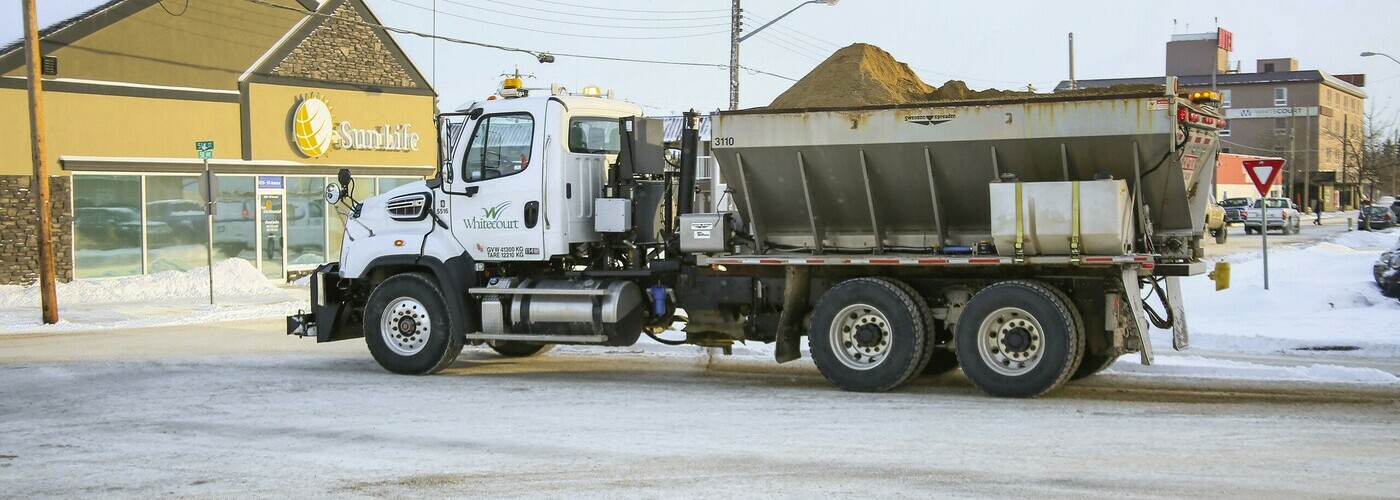Road Bans in effect March 19,2025
Spring road bans take effect on Wednesday, March 19, 2025 as per the Road Bans Bylaw 1564.
This will restrict commercial and heavy vehicles to seventy‐five percent (75%) of authorized load limits on chip‐sealed, oil‐surfaced, cold‐mix surfaced, millings‐surfaced, and gravel roads within the Town of Whitecourt corporate boundary. This includes:
- Flats Connector
- Flats Road from Flats Connector to the east Town boundary
- 41 Ave East from 30 Street to the east Town boundary
- West Whitecourt - west of Highway 43
- West Road
- 66 Street
- Westview Road
- 50 Avenue
- 51 Avenue
- 53 Avenue
- 33 Street south of Highway 43 [Forest Interpretive Centre (FIC) Road] up to the Town boundary
Roads & Street Maintenance
Local Roads
To report a street or traffic light malfunction, or other road maintenance concern, please contact the Infrastructure Services Department at 780-778-2273.
Highway 43 and 32
If you have questions regarding maintenance or safety of Highway 43 and 32 please contact Ledcor at https://ledcorhighways.com/contact-us/.
CN Rail
If you have non-emergency concerns regarding noise, train whistling, or trains blocking a crossing, please contact CN at 1-888-888-5909 (phones are answered Monday to Friday 9am to 6pm ET) or contact@cn.ca.
Road Bans
Preventing road damage by weight restrictions
We need weight restrictions to prevent damage to the Town of Whitecourt roads.
In the spring, frozen roads start to thaw. During spring, roads are weakened by excess water in the road base and can be damaged by heavy vehicles. The thawing water may not drain out of the gravel that is under the pavement. This is because the surrounding soil may be frozen or too solid. The water will soak into the gravel. When the water is absorbed, the road will temporarily lose strength. When this happens, the road cannot support heavier vehicles. Gravel roads are more vulnerable or susceptible to damage.
This will restrict commercial and heavy vehicles to seventy-five percent (75%) of authorized load limits on chip-sealed, oil-surfaced, cold-mix surfaced, millings-surfaced, and gravel roads within the Town of Whitecourt corporate boundary.
Please watch for and obey signage.
Road Use Permit Application (Fillable)
Road Bans in effect March 19, 2025
Spring road bans take effect on Wednesday, March 19, 2025 as per the Road Bans Bylaw 1564.
This will restrict commercial and heavy vehicles to seventy‐five percent (75%) of authorized load limits on chip‐sealed, oil‐surfaced, cold‐mix surfaced, millings‐surfaced, and gravel roads within the Town of Whitecourt corporate boundary. This includes:
- Flats Connector
- Flats Road from Flats Connector to the east Town boundary
- 41 Ave East from 30 Street to the east Town boundary
- West Whitecourt - west of Highway 43
- West Road
- 66 Street
- Westview Road
- 50 Avenue
- 51 Avenue
- 53 Avenue
- 33 Street south of Highway 43 [Forest Interpretive Centre (FIC) Road] up to the Town boundary
Do you have questions about the road ban and/or road use permits? Contact the Director of Infrastructure Services at 780-778-2273 or administration@whitecourt.ca.
Snow & Ice Control
The Town of Whitecourt utilizes a variety of snow clearing and ice control methods to keep Whitecourt roads and walkways safe.
Snow & Ice Control Practices
The Town's initial action is to spread sand at intersections and slippery locations. This is followed by clearing (plowing), and removal of snow in limited areas. These activities take place seven days a week, at all hours that staff and equipment are available.
Road and sidewalks are done in a priority order to maximize safe travel for the greatest number of users.
-
Major arterial roads and collector roadways, to give good access to within a few blocks of most areas and allow school bus operations.
-
Downtown business district, to allow owners time in advance to clean adjacent sidewalks.
-
Residential or local roadways.
-
Industrial roads.
For information on the current snow removal schedule and other road information, follow Whitecourt on Facebook.
Did you know?
During snow season our crews are ready to clear local roads as quickly and effectively as possible. We maintain the following:
- 130 lane kilometres of roads;
- 16 public buildings and facilities;
- 43 transit bus shelters/pads/stops;
- 8 kilometres primary priority pathways and 6 kilometres of secondary priority pathways;
- 4 outdoor rinks;
- Rotary Park pond;
- public facilities parking lots;
- 8 sewer lift stations;
- water intake; and
- Water Treatment Plant
In total, Whitecourt employs 6 operators to clear roads and 9 staff members to maintain pathways and facilities during the winter months. We appreciate residents’ patience and understanding as we work to maintain and clear local infrastructure.
